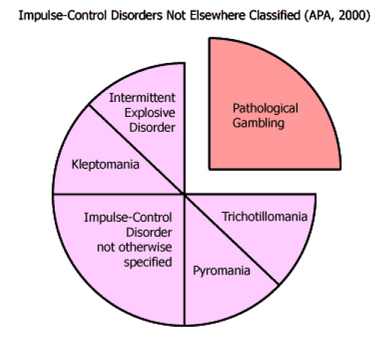The WAGER 6(5) – DSM-IV Nosology: Should Pathological Gambling be “Elsewhere Classified”?
The past two issues of the WAGER have scrutinized DSM-IV (Vol. 6 No. 4, Vol. 6, No. 3). This week, the series continues with a brief examination of the manual’s categorization of pathological
gambling. Specifically, DSM-IV classifies pathological gambling within the category of “Impulse-Control Disorders Not Elsewhere Classified” (APA, 2000). Other disorders included in this category are Intermittent Explosive Disorder, Kleptomania, Pyromania, Trichotillomania, and Impulse-Control Disorder Not Otherwise Specified. Classifying pathological gambling as an impulse-control disorder represents the first attempt to nosologically fit intemperate gambling into the psychiatric diagnostic schema.
Theoretically, grouping pathological gambling with impulse
disorders like kleptomania and pyromania suggests that pathological gambling is the result of the same underlying irrepressible impulse that is common to the impulse disorders with which it is classified. DSM-IV, however, does not describe the discrepancies between pathological gambling and these other impulse disorders. Impulse control disorders like kleptomania and pyromania are very uncomfortable experiences. Those affected by these disorders feel overwhelmed by an impulse to act and often report a sense of relief after having acted. This discomfort is ego dystonic. That is, the experience is ego alien: sufferers do not want to steal or set fires, but they do it to relieve an overwhelming impulse to act. On the contrary, while in action, pathological gamblers often find their gambling enjoyable, or ego syntonic. Typically, only after the gambling is terminated or losses are incurred do pathological gamblers begin to feel distress and dystonia (Shaffer, 1999)
Indeed, if pathological gambling is similar to kleptomania and pyromania—and driven by similar irrepressible impulses rather than an irrepressible habit—then there must be validation of the impulse or impaired regulatory mechanisms (Kipnis, 1997). With very few exceptions (e.g., Bergh, Sodersten, & Nordin, 1997; Blum et al., 2000; Christenson et al., 1994; Ebstein et al., 1996; Lejoyeux, Ades, Tassain, & Solomon, 1996; Ninan et al., 2000; Orford, 1985), investigators have not focused on the impulse disorders for commonalities. Instead, most investigators compare gambling disorders with substance use disorders.
Given the questions regarding the placement of pathological gambling within DSM-IV, scientists have an important opportunity to improve our collective understanding of excessive behavior patterns. For example, if pathological gambling fails to meet strict criteria as an impulse-control disorder, and since substance abuse and other disorders have impulse-control attributes, then perhaps it is time to reconsider the nosological schema for these often overlapping and synergistic patterns. DSM-IV is truly a work in progress with a host of diagnostic issues that can be addressed in DSM-V (Widiger & Clark, 2000).
Ultimately, the scientific debate over DSM-IV’s classification of pathological gambling encourages new research on both the impulsive and addictive components of pathological gambling. Indeed, more scientific evidence is necessary to determine the extent of attributes associated with pathological gambling and its rightful place in the diagnostic nosology. A thoughtful classification of pathological gambling will improve the identification and treatment of pathological gamblers, as well as benefit our understanding of disorders that involve impulse dysregulation both solely and in part.
References
American Psychiatric Association. (2000). DSM-IV (TR): Diagnostic and Statistical Manual of Mental Disorders (Fourth). Washington, DC: American Psychiatric Association.
Bergh, C., Sodersten, E. P., & Nordin, C. (1997). Altered dopamine function in pathological gambling. Psychological Medicine, 27, 473-475.
Blum, K., Braverman, E. R., Holder, M. M., Lubar, J. F., Monastra, V. J., Miller, D., Lubar,
J. O., Chen, T. J. H., & Commings, D. E. (2000). Reward deficiency syndrome: a biogenetic model for the diagnosis and treatment of impulsive, addictive, and compulsive behaviors. Journal of Psychoactive Drugs, 32(supplement), 1-112.
Christenson, G. A., Faber, R. J., de Zwaan, M., Raymond, N. C., Specker, S. M., Edern, M. D., Mackenzie, T. B., Crosby, R. D., Crow, S. J., D., E. E., Mussell, M. P., & Mitchell, J. E. (1994). Compulsive buying: descriptive characteristics and psychiatric comorbidity. The Journal of Clinical Psychiatry, 55(1), 5-11.
Ebstein, R. P., Novick, O., Umansky, R., Priel, B., Osher, Y., Blaine, D., Bennett, E. R., Nemanov, L., Katz, M., & Belmaker, R. H. (1996). Dopamine D4 receptor (D4DR) exon III polymorphism associated with the human personality trait of novelty seeking. Nature Genetics, 12(January), 78-80.
Kipnis, D. (1997). Ghosts, taxonomies, and social psychology. American Psychologist, 52(3), 205-211.
Lejoyeux, M., Ades, J., Tassain, V., & Solomon, J. (1996). Phenomenology and Psychopathology of Uncontrolled Buying. American Journal of Psychiatry December, 153(12), 1524-1529.
Ninan, P. T., McElroy, S. L., Kane, C. P., Knight, B. T., Casuto, L. S., Rose, S. E., Marsteller, F. A., & Nemeroff, C. B. (2000). Placebo-Controlled Study of Fluvoxamine in the Treatment of Patients With Compulsive Buying. Journal of Clinical Psychopharmacology, 20(3), 362-366.
Orford, J. (1985). Excessive appetites: a psychological view of addictions. New York: John Wiley & Sons.
Shaffer, H. J. (1999). Strange bedfellows: a critical view of pathological gambling and addiction. Addiction, 94(10), 1445-1448.
Widiger, T. A., & Clark, L. A. (2000). Toward DSM-V and the classification of psychopathology. Psychological Bulletin, 126(6), 946-963.
The WAGER is a public education project of the Division on Addictions at Harvard Medical
School. It is funded, in part, by the National Center for Responsible Gaming, the
Massachusetts Department of Public Health, the Addiction Technology Transfer Center of
New England, the Substance Abuse and Mental Health Services Administration, and the
Center for Substance Abuse Treatment.
